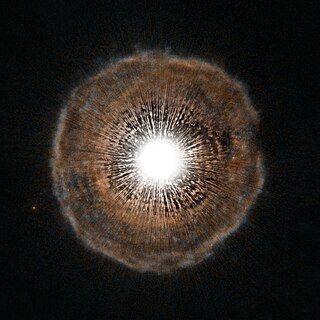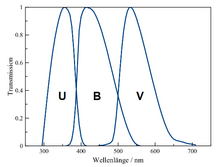
Apparent magnitude is a measure of the brightness of a star or other astronomical object. An object's apparent magnitude depends on its intrinsic luminosity, its distance, and any extinction of the object's light caused by interstellar dust along the line of sight to the observer.

Photometry, from Greek photo- ("light") and -metry ("measure"), is a technique used in astronomy that is concerned with measuring the flux or intensity of light radiated by astronomical objects. This light is measured through a telescope using a photometer, often made using electronic devices such as a CCD photometer or a photoelectric photometer that converts light into an electric current by the photoelectric effect. When calibrated against standard stars of known intensity and colour, photometers can measure the brightness or apparent magnitude of celestial objects.
Photometric-standard stars are a series of stars that have had their light output in various passbands of photometric system measured very carefully. Other objects can be observed using CCD cameras or photoelectric photometers connected to a telescope, and the flux, or amount of light received, can be compared to a photometric-standard star to determine the exact brightness, or stellar magnitude, of the object.

A B-type main-sequence star is a main-sequence (hydrogen-burning) star of spectral type B and luminosity class V. These stars have from 2 to 16 times the mass of the Sun and surface temperatures between 10,000 and 30,000 K. B-type stars are extremely luminous and blue. Their spectra have strong neutral helium absorption lines, which are most prominent at the B2 subclass, and moderately strong hydrogen lines. Examples include Regulus and Algol A.

In astronomy, magnitude is measure of the brightness of an object, usually in a defined passband. An imprecise but systematic determination of the magnitude of objects was introduced in ancient times by Hipparchus.

An asteroid spectral type is assigned to asteroids based on their reflectance spectrum, color, and sometimes albedo. These types are thought to correspond to an asteroid's surface composition. For small bodies that are not internally differentiated, the surface and internal compositions are presumably similar, while large bodies such as Ceres and Vesta are known to have internal structure. Over the years, there has been a number of surveys that resulted in a set of different taxonomic systems such as the Tholen, SMASS and Bus–DeMeo classifications.
Photographic magnitude is a measure of the relative brightness of a star or other astronomical object as imaged on a photographic film emulsion with a camera attached to a telescope. An object's apparent photographic magnitude depends on its intrinsic luminosity, its distance and any extinction of light by interstellar matter existing along the line of sight to the observer.
In astronomy, a photometric system is a set of well-defined passbands, with a known sensitivity to incident radiation. The sensitivity usually depends on the optical system, detectors and filters used. For each photometric system a set of primary standard stars is provided.
Vilnius photometric system is a medium-band seven-colour photometric system (UPXYZVS), created in 1963 by Vytautas Straižys and his coworkers. This system was highly optimized for classification of stars from ground-based observations. The system was chosen to be medium-band, to ensure the possibility to measure faint stars.
The Strömgren photometric system, abbreviated also as uvbyβ or simply uvby, and sometimes referred as Strömgren - Crawford photometric system, is a four-colour medium-passband photometric system plus Hβ (H-beta) filters for determining magnitudes and obtaining spectral classification of stars. Its use was pioneered by the Danish astronomer Bengt Strömgren in 1956 and was extended by his colleague the American astronomer David L. Crawford in 1958.
A photometric redshift is an estimate for the recession velocity of an astronomical object such as a galaxy or quasar, made without measuring its spectrum. The technique uses photometry to determine the redshift, and hence, through Hubble's law, the distance, of the observed object.
A color–color diagram is a means of comparing the colors of an astronomical object at different wavelengths. Astronomers typically observe at narrow bands around certain wavelengths, and objects observed will have different brightnesses in each band. The difference in brightness between two bands is referred to as color. On color–color diagrams, the color defined by two wavelength bands is plotted on the horizontal axis, and the color defined by another brightness difference will be plotted on the vertical axis.
The AB magnitude system is an astronomical magnitude system. Unlike many other magnitude systems, it is based on flux measurements that are calibrated in absolute units, namely spectral flux densities.
The Ultraviolet and Optical Telescope (UVOT) is one of three instruments on board the Neil Gehrels Swift Observatory that observes astronomical objects in its 17-by-17 arc minute field of view through one of several filters or grisms. The seven filters, which are similar to those on the XMM-Newton Optical Monitor instrument, cover the near-ultraviolet and optical range. The brightness of an object observed in the three optical filters, called u, b, and v, can be converted into the more common Johnson-Morgan magnitudes. The three ultraviolet filters probe a spectral region that is not observable from the ground.
The Cape Photographic Catalogue (CPC) is a star catalogue containing 68,467 stars in the Southern Hemisphere whose declinations are either between −30° and −40° or between −52° and −90°. It contains positions, proper motions, magnitudes, and spectral types, and was published by the Cape Observatory between 1954 and 1968. This was the last major astronomical catalogue to be assembled without the use of photoelectric sequences.

Starlight is the light emitted by stars. It typically refers to visible electromagnetic radiation from stars other than the Sun, observable from Earth at night, although a component of starlight is observable from Earth during daytime.
In astronomy, the color index is a simple numerical expression that determines the color of an object, which in the case of a star gives its temperature. The lower the color index, the more blue the object is. Conversely, the larger the color index, the more red the object is. This is a consequence of the logarithmic magnitude scale, in which brighter objects have smaller magnitudes than dimmer ones. For comparison, the whitish Sun has a B−V index of 0.656 ± 0.005, whereas the bluish Rigel has a B−V of −0.03. Traditionally, the color index uses Vega as a zero point.

U Camelopardalis is a semiregular variable star in the constellation Camelopardalis. Based on parallax measurements made by the Hipparcos spacecraft, it is located about 3,000 light-years away from the Earth. Its apparent visual magnitude is about 8, which is dim enough that it cannot be seen with the unaided eye.

Xuntian, also known as the Chinese Survey Space Telescope (CSST) is a planned Chinese space telescope currently under development. It will feature a 2-meter diameter primary mirror and is expected to have a field of view 300–350 times larger than the Hubble Space Telescope. This will allow the telescope to image up to 40 percent of the sky using its 2.5 gigapixel camera over ten years.








